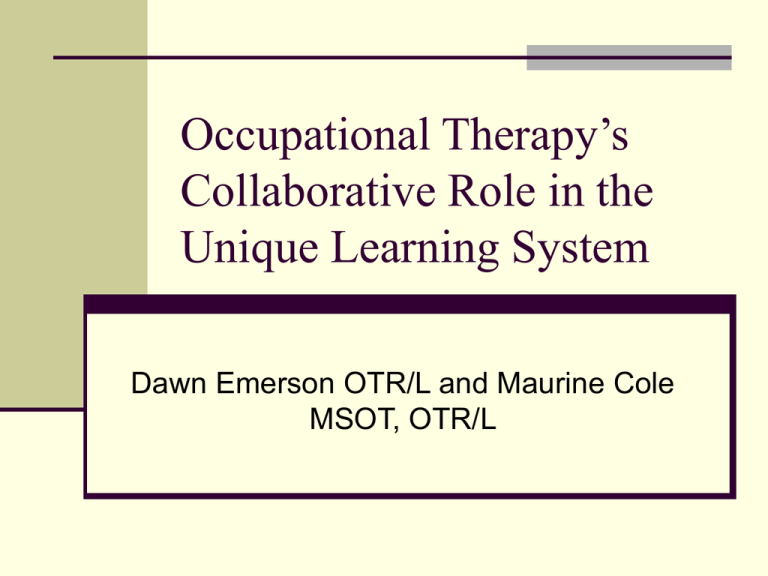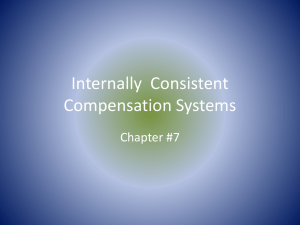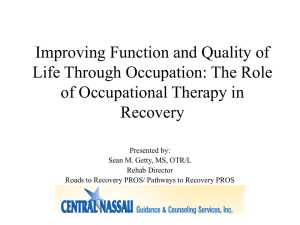Occupational Therapy and ULS
advertisement

Occupational Therapy’s Collaborative Role in the Unique Learning System Dawn Emerson OTR/L and Maurine Cole MSOT, OTR/L Occupational Therapy in the Schools Occupational therapy practitioners promote functional abilities and engagement in daily routines. OT supports the child’s “occupation” of life skills and the role of a student Addresses areas including academic and non-academic outcomes such as social skills, behavior management, prevocational involvement, and more for children ages 3-21 (AOTA, 2010) Scope of Practice Sensory Awareness/processing: somato-sensory, vestibular, proprioceptive, visual, auditory, gustatory, olfactory information Neuromotor Functions: muscle tone, range of motion, postural control, strength and endurance Motor skills- fine, gross, visual motor: coordination and balance, bilateral integration, motor planning, hand preference, manipulation, visual-motor integration, crossing the midline Perceptual skills: attention, visual perception, body scheme, orientation, spatial awareness Adaptive behavior: social interaction, social problem solving, selfcontrol, classroom/personal organization (Hanft and Place, 1996) The Law Under Part B of IDEA 2004 (IDEIA) OT (and PT) services function as “related services” under which are defined as those services “required to assist a child with a disability to benefit from special education” (34 CFR § 300.34(a)). California Code of Regulations, Title 5, Section 56363(a) “the general education teacher and/or special education teacher provide the instruction and services if the provision of the instruction and services by the teacher is feasible. If not, the appropriate designated instruction and services (i.e. related services) specialist shall provide the instruction and services. “ The Law This means that related services support the educational team when the need is above and beyond the scope of practice of the teacher Mandates the provision of special education, related services, and early intervention services, in the least restrictive or natural environment to the greatest extent possible. In other words, “contextual services” Contextual Services Contextual services refers to the provision of occupational therapy interventions within the child’s everyday activities and routines; considered best practice in occupational therapy and special education(Handley-More et.al, 2013) Practice in familiar contexts is the key to generalization and mastery of skill(Fishbaugh,2000), therefore alternatives to direct intervention in a pull-out model should be explored.( Morris 2013) California Department of Education Guidelines -2012 “Occupational therapy … work with the educational team to support a child’s ability to gain access to the general education curriculum, meet state standards, make adequate yearly progress, participate in postsecondary education, and become functional independent citizens upon graduation.” “In school-based practice, both OTs and PTs view disability in terms of the ways in which a child is faced with activity limitations and participation restrictions, instead of a focus on projected limitations of a singular diagnosis, disease, or disorder. The child’s activity limitations and participation restrictions experienced in gaining access to the educational program are assigned a high priority.” OT and Curriculum “The Educational Framework for Child Success (EFCS), continues to emphasize the importance of performance in the context of the school environment also highlights the importance of curriculum; evidenced-based practice; team collaboration; and ongoing as well as future postsecondary child outcomes, in alignment with IDEA 2004 and NCLB 2002.” (CDE 2012) OT and Curriculum In this model there is a direct relationship between the common core standards and the needs, goals, and projected outcomes of the students There is a need to monitor progress, collect data, and provide services based on this data to promote effective learning (CDE 2012) OT is also becoming more involved in the Response to Intervention (RtI) programs as part of Early Intervening Services (EIS) Unique Learning System An online, dynamic standards-based curriculum for special education Uses instructional targets to bridge between standards and the curriculum content for students with disabilities Targets are aligned with the Common Core Standards for English Language Arts and Mathematics (www.n2y.com) Unique Learning Systems Subscribers download monthly instructional thematic units of study Each unit contains 30 lesson plans and downloadable materials The lesson plans define three levels of tasks to accommodate the diversity of learners with significant disabilities Unique Learning System Organizes curriculum into grade bands: Preschool, Elementary (K-2), Intermediate (35), Middle School (6-8), High School (9-12) and Transition (12+) All students participate in the same activity with different levels of expectation Unique Learning System Level 1: Students require maximum supports. Increasing participation is the main objective. Level 2: Students may require picture support and other direct support in learning and demonstrating comprehension. Level 3: Students can read text, produce simple writing, perform basic math processes, and can independently demonstrate comprehension of modified learning information. ( ULS website) How can OT support ULS? Consistently mindful of the child’s IEP goals and relationship of the ULS activities to the overall focus area of each goal OT may provide support services through the collaborative planning of activities with the classroom teacher and during the planned activities within the classroom setting Utilizing the framework of the OT Scope of Practice ( slide 3) to analyze each ULS activity ULS Activity Analysis Activity demands: required motor skills (fine/gross), cognitive level, independence level, time demands, Characteristics of supplies: size, quantity, sensory nature, safety, sequence, storage, set up/clean up Positioning: neuromuscular status (muscle tone, strength, balance, coordination), sensory preferences, work station, placement of child in relationship to peers, staff and supplies, modifications to environment as needed to facilitate task engagement ULS Activity Analysis Supports: visual, auditory, staff, behavioral Individual needs of the child in relationship to the whole class “Just Right Challenge” Discussion of Example Moderate/severe, 4th-6th grade, Unit theme: Recycling Activity: Sorting glass, paper, plastic Activity demands: identify item, match to correct container, place within the container, turn taking, grading of pressure to manipulate items Characteristics of supplies: appropriate size/weight of items, no sharp edges, potential allergies, variety of items to match sorting skill level, size, type (clear or solid) and placement of sorting containers Discussion of Example Positioning: Stand vs sit, movement vs stationary task, sensory preferences adaptations, work station ergonomics, reduction of environmental distractions Supports: PECS, “first/then”, visual schedule, picture jig, self regulation tools, verbal/physical prompts from staff, behavioral supports Needs of individual child in relationship to whole class: BIP/BSP, individual vs group activity, specific placement related to peers, accommodations and strategies related to IEP Conclusion The goal of this task analysis is to provide the child with the “just right challenge” that allows him to participate in the least restrictive environment in order to make progress towards the IEP goals. Questions/Comments References American Occupational Therapy Association. 2008. Occupational Therapy practice Framework: Domain & Process. 2nd ed. Bethesda, MD: American Occupational Therapy Association. American Occupational Therapy Association. 2010. Occupational Therapy in School Settings. Bethesda, MD: American Occupational Therapy Association. American Occupational Therapy Association. 2009. Scope of Practice. American Journal of Occupational Therapy, 63. California Department of Education. 2010. Common Core State Standards http://www.cde.ca.gov/re/cc/ccssfaqs2010.asp California Department of Education. 2012. The Guidelines for Occupational and Physical Therapy in California Public Schools (2nd Edition). CDE Press; Sacramento, CA. References Individuals with Disabilities Education Improvement Act of 2004, Pub. L. 108-446, 20 U.S.C. §1400 et seq. Handley-Moore, D.; Wall, E.; Orentlicher, M.L.; Hollenbeck, J. 2013. Working in Early Intervention and School Settings: Current Views of Best Practice. Special Interest Section Quarterly: Early Intervention and Schools, Vol. 20, Number 2. June 2013. American Occupational Therapy Association, Inc. Bethesda, MD. Hanft, B. and Place, P. 1996. The Consulting Therapist: A Guide for OTs and PTs in Schools. Therapy Skill Builders; Texas. Morris, M.L. 2013. Collaboration in Schools: Perspectives of Occupational Therapist and Teacher Dyads. Special Interest Section Quarterly: Early Intervention and Schools, Vol. 20, Number 1. March 2013. American Occupational Therapy Association, Inc. Bethesda, MD. U.S. Department of Education http://idea.ed.gov




